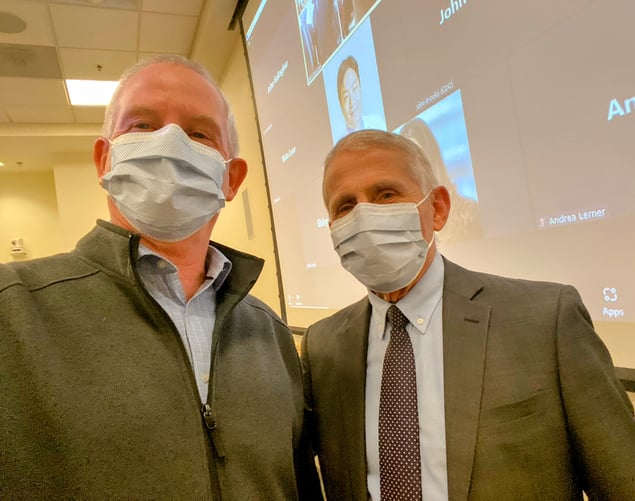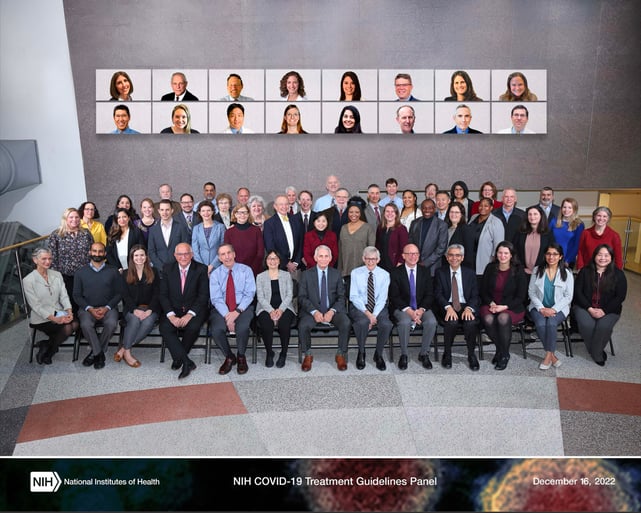When the COVID-19 pandemic hit the United States in 2020 and left millions of people with unanswered questions, a panel of experts from across the country assembled to try to find answers, including the University of Colorado Department of Medicine’s own Steven Johnson, MD.
Johnson, a professor in the Division of Infectious Diseases, jumped at the opportunity to join the panel, called the National Institutes of Health COVID-19 Treatment Guidelines Panel. Through countless hours of work and collaboration, the panel created and continually updated national guidelines for health care providers on how to treat COVID-19.
Now, nearly four years after its formation, the panel has sunsetted, issuing its final update on Feb. 29, 2024. For Johnson, it was an unparalleled career experience.
“This was a unique thing, to be involved with a brand new disease that had so much importance and so much of a global impact,” he said.
Getting involved in the panel
Johnson’s involvement on the COVID-19 treatment guidelines panel stemmed from his work on developing guidelines for another global virus — HIV.
“I paid for medical school with an Army scholarship,” said Johnson, who graduated from Northwestern University Feinberg School of Medicine in 1984. “When I did my internal medicine residency, I actually came to Fitzsimons.”
At that time, the Fitzsimons Building, located at the CU Anschutz Medical Campus, was an Army medical center. When he was a medical resident, it was one of the main referral centers to evaluate people with HIV, Johnson said.
“There were not a lot of great treatments and young people were dying, and so that’s what led me to go into infectious diseases,” he said. “Once I had paid back my time in the military, I came here in 1994 to oversee the infectious diseases clinic, which was predominantly an HIV clinic at the time. I’ve made HIV the major focus of my career ever since.”
Since 2018, Johnson has served on a federal HIV guidelines panel called the Department of Health and Human Services Panel on Antiretroviral Guidelines for Adults and Adolescents. Being a member of that panel led to his invitation to the COVID-19 treatment guidelines panel, which consisted of 57 members in total.
“What are the two important viral pandemics in my lifetime? It’s HIV and it’s COVID-19, and I was able to be a part of developing guidelines for both of them,” Johnson said.

From left to right: Steven Johnson, MD, a professor in the Division of Infectious Diseases at the University of Colorado School of Medicine, with Anthony Fauci, MD, who served as the director of the National Institute of Allergy and Infectious Diseases from 1984 to 2022.
Creating guidelines in uncertain times
The COVID-19 treatment guidelines panel was quickly assembled in March 2020, the same month the World Health Organization declared COVID-19 a pandemic with more than 571,600 confirmed global cases as of March 28, 2020.
The panel was formed in response to a request from the White House Coronavirus Task Force, according to a 2021 article written by the panel that was published in the Annals of Internal Medicine. Within four days of that request, the panel was established and began tackling a major challenge: to create guidance for the treatment of a new, evolving disease that was rapidly spreading and overwhelming hospitals.
“This specific set of guidelines was born out of a public health crisis where providers needed rapid information,” Johnson said.
The first step was developing the organizational structure, he said. The panel split into teams that each focused on different aspects of COVID-19, equipped with their own outlines of what to cover in the guidelines.
Johnson was on team one, which was involved with describing the clinical aspects of COVID-19 such as how to diagnose it. The second team focused on antiviral therapies, the third team concentrated on immunotherapies and the fourth team centered on critical care.
Members of the teams would work to interpret medical literature, evaluate whether studies conflicted with one another, weigh the different types of evidence, gather information about who is advocating for what, and collaborate with other experts.
For example, Johnson said the panel would invite lead authors of relevant medical studies to meet with the panel to discuss why they interpreted data in a certain way and learn additional information that was not published.
“Similarly, the pharmaceutical companies that were developing medications, monoclonal antibodies, and vaccines, we could also invite them on to present their data,” he said. “You really felt like you were seeing the data in real time and also in greater depth.”
On his team, one of Johnson’s big areas of focus was the intersection of HIV and COVID-19, specifically looking at how people with HIV handled a COVID-19 infection. In some ways, he said COVID-19 was reminiscent of the early days of HIV.
“People were desperate to understand the disease better, desperate to get medications, and so it was that same kind of urgency,” he said.
Moving as fast as possible, the panel published its first iteration of COVID-19 treatment guidelines on April 21, 2020.
“The early days of COVID-19, I think a lot of people would admit, were personally frightening at times, especially prior to the vaccinations,” Johnson said. “The guidelines provided a roadmap at a time when people needed a roadmap.”

The National Institutes of Health COVID-19 Treatment Guidelines Panel on Dec. 16, 2022. Steven Johnson, MD, is standing in the second row from the back, second person from the far right.
Reflecting on years of work and lessons learned
Since April 2020, the guidelines have been viewed more than 50 million times by people in the U.S. and across the world, Johnson said.
“The most rewarding aspect was the speed with which we developed effective guidelines and recommendations — and knowing that these guidelines were being looked at by people who were on the front line,” he said.
Keeping up-to-date content was a challenge, as the standards of care changed rapidly and so the guidelines required constant editing, he said. Over the years, the panel updated the guidelines more than 70 times.
“One of the things I think we're most proud of is we resisted non-scientific influences,” Johnson said. “Nearly every decision we made about whether to recommend something or not turned out, in the end, to be the right decision. That was really something to be proud of.”
The decision to sunset the panel in February 2024 was a poignant moment, he said.
“We’ve worked as a team,” he said, adding that the guidelines added up to more than 400 pages. “It’s essentially a textbook that we put together.”
One of the reasons for the panel’s end is because it was set up in response to the public health emergency of COVID-19, he said. As that emergency has dialed down, it made sense that this set of guidelines would dial down as well. Specialty medical societies may take over this task going forward.
The work of treating and researching COVID-19 is not over, he noted, but it was sad to say goodbye to a panel he had worked with so closely for four years.
“It really was a once-in-a-career experience,” Johnson said.




